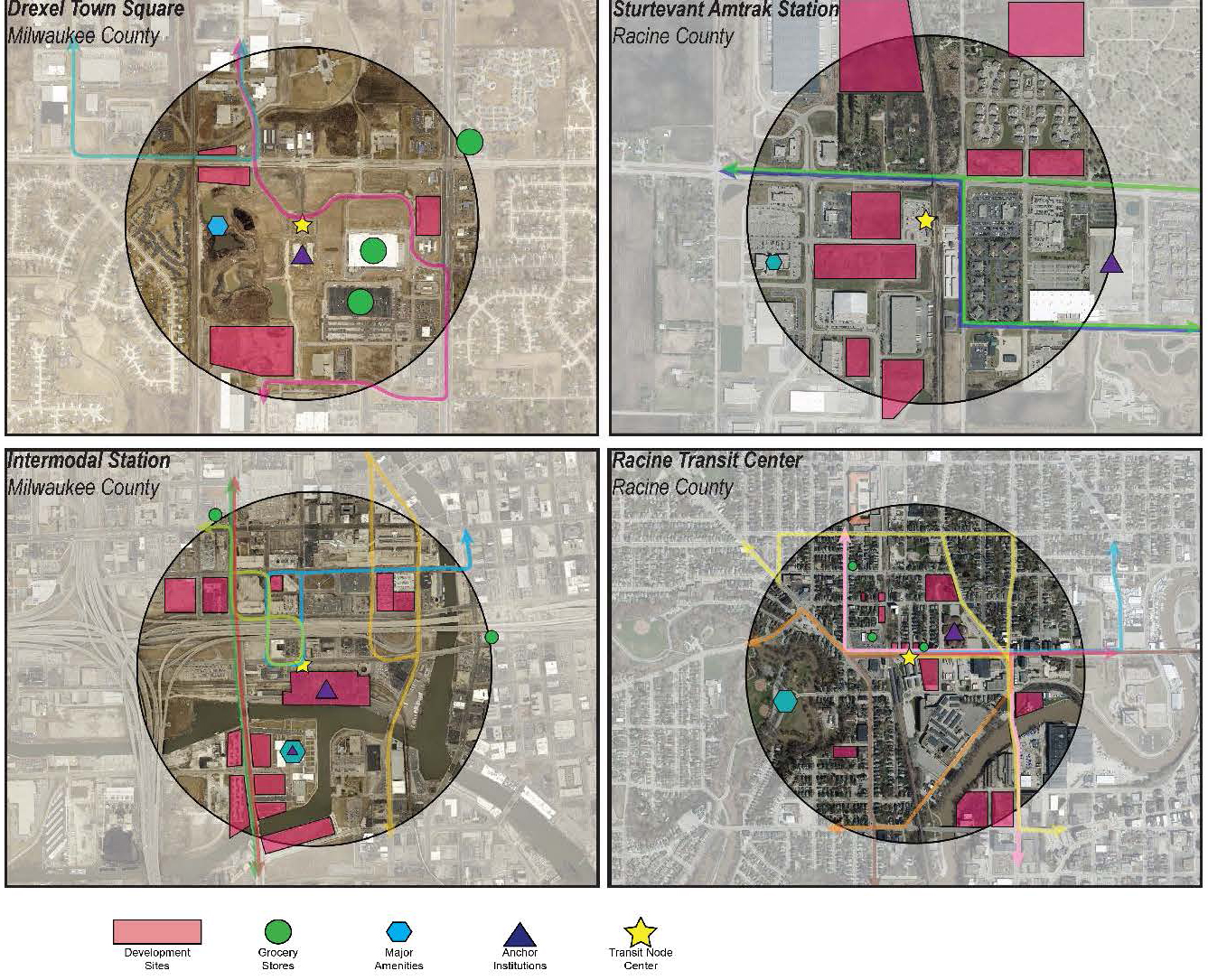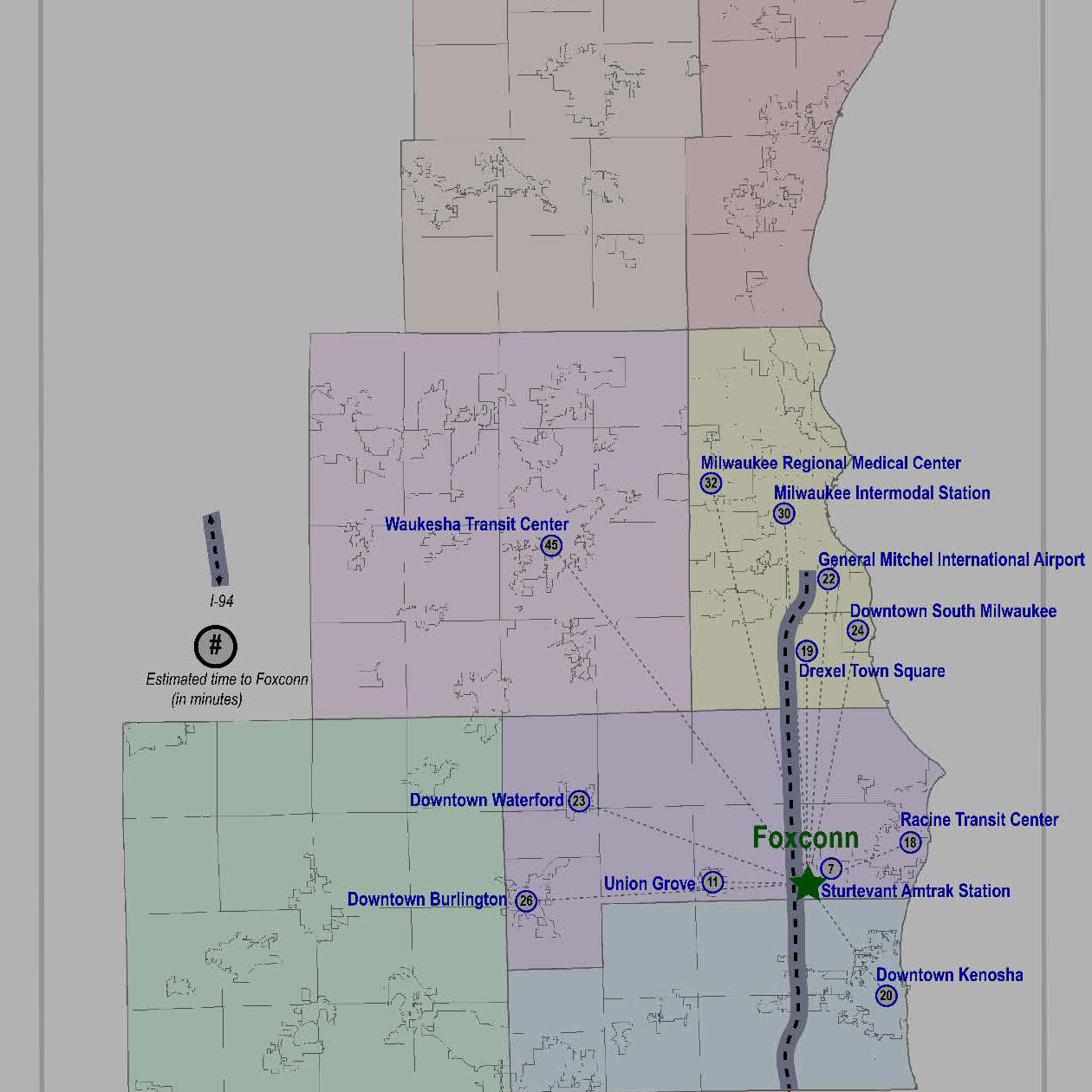We have the right links, but not the right “places”
Our circulation links are the lines that connect the two key places – from home to work. We think that the problem is not one of missing lines but one of missing places where efficient and economically viable connections can occur. That is, we need a third place in the middle, between home and work. This middle place is a connection point that must be located in a neighborhood center – the core of an intermodal neighborhood.
What is an intermodal neighborhood?
Over time, this middle place becomes the center of an intermodal neighborhood. It is this middle place where many different modes of circulation come together. In simple terms, employees take one mode of circulation to the center and then another mode to their job. There are two journeys instead of one. Each journey has greater ridership and efficiency. At the same time, the surrounding neighborhood can become stronger both socially and economically through increased density and frequent activity.
Hidden benefits of intermodal neighborhoods
By their nature, intermodal neighborhoods become socially diverse, economically sustainable, and environmentally friendly. Over time, higher density intermodal neighborhoods dramatically reduce the per capita cost of physical infrastructure. A key secondary impact of this model is it facilitates the continuation of developing suburban business parks and job centers.
How can planners make this happen?
Every community is different. Some need to form alliances among employers in suburbs. Other communities may need to create a better intermodal transfer point. Almost all solutions require intergovernmental cooperation among the subregions of urban, suburban, and rural communities. This is the perfect opportunity for planners to provide analysis, support, and action plans.
These four locations (Drexel Town Square, Racine Amtrak Station, Menomonee Valley, and Racine’s Downtown Riverfront) represent places with potential to become major intermodal neighborhoods with effective transfer points from (a) an employee’s residence to (b) a neighborhood center and then to (c) a more distant job cluster.
This more detailed view of an earlier plan for Drexel Town Square shows an excellent transfer point that can lead to a strong intermodal neighborhood.
Where are intermodal neighborhoods and how do we get there?
We have identified at least 12 locations for intermodal neighborhoods and districts in southeastern Wisconsin. Some are already connected to employees who live within these intermodal neighborhoods or can reach them efficiently. In very dense urban areas, workers may get to the center by walking or bicycling. In other centers they may arrive via a local shuttle bus or by ride sharing.
Where are the job clusters?
Many employers are already located in job clusters, such as business parks. Solutions that just bring workers to one business could be expanded to reach several employer locations within short distances of each other. For example, there might be three of four shuttle buses going to one business park – each shuttle would come from a different intermodal neighborhood and would drop off employees at any of the businesses within that one business park.
Why doesn't this happen now?
In practice, this already happens – but not enough. There are business parks and major job centers that provide shuttle service and similar programs for their employees (for example, Potawatomi’s Lyft program). These programs could be made more efficient and cost-effective, however, if employees were able to easily congregate at a central point of collection, which would increase ridership and reduce the number of connections that need to be made.
GRAEF has worked in numerous communities in southeastern Wisconsin. Many neighborhoods and districts could easily serve as the focus for an intermodal connection center. Each would differ in how it operates, who lives nearby, how people arrive from work, and how employers take employees to their jobs.
Why this must be a bottom-up solution led be planners
This type of coordination cannot be resolved in a singular, top-down, centralized system. Furthermore, there will never be one transportation mode that works for all neighborhoods and all types of job clusters. Planners will need to work with numerous county-wide, region-wide, and state-wide agencies and experts to provide the needed logistical analysis and expertise. Moreover, regional funding and intergovernmental alliances will be needed, but the actual solutions must vary to fit local circumstances.
Resiliency Requires Multiple Last Mile Solutions
In the same way that there is no single type of residential or commercial solution for all our communities, so too is there no single solution to the “last mile” problem. Planners can, and should, take the initiative to find local job clusters, potential intermodal neighborhoods and districts, and begin the intergovernmental and private-public dialogue needed to create decentralized solutions. As one area demonstrates success, it will encourage other areas to follow. Over time we should be able to scale-up this approach to work on a much broader basis (for example, connecting intermodal neighborhoods to each other). As the system is developed, new ideas will emerge, and subsystems will evolve. This approach will give us a truly resilient, sustainable system of jobs, homes, and neighborhoods.
These four illustrations tell a story about how an “intermodal neighborhood” might evolve over time. The map encircles South Milwaukee’s downtown. Historically the area was filled with manufacturing jobs abutting its traditional Main street. Today, the factory jobs have gone but the main street (shown at twilight is still spectacular, and still surrounded by strong residential areas. If the downtown becomes a neighborhood center with intermodal transfer points (as shown in a photomontage) then it can help the downtown grow its reputation as a destination center (already begun with the bustling farmer’s market).


